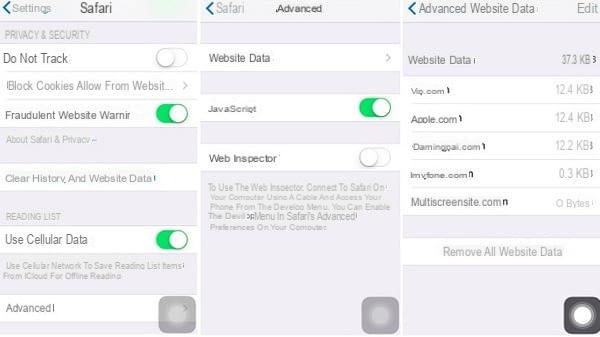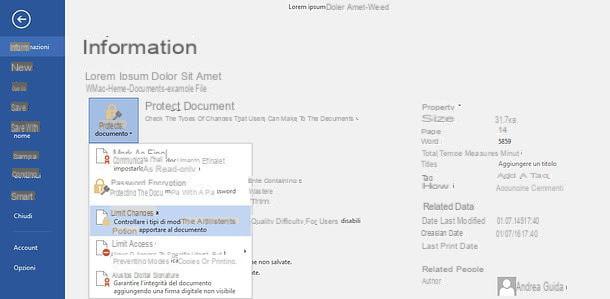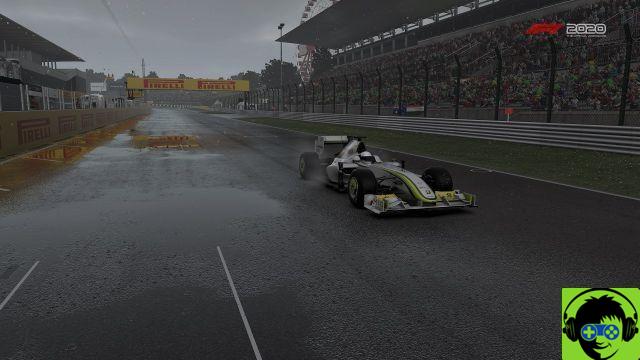Differences between indexing and positioning

Before getting to the heart of this guide and explain yourself how to index a WordPress site, you may find it useful to know what it means to index a website and what are the differences between indexing and positioning on search engines.
First, you need to know that index a website it means making it appear in the SERP (Search Engine Result Page), i.e. in the search results page. In simple terms, indexing is a procedure, which is usually done automatically as soon as the website goes online. Simply put, i robot (also called crawler o spider), i.e. software that analyzes the contents of a website automatically on behalf of search engines, have access to the pages of the site and can scan the contents in order to position them on the search results pages for certain keywords. In rare cases, the procedure does not take place automatically and you can "suggest" directly to Google or other search engines to index a site.
And what does it mean, instead, positioning on search engines? By positioning we mean the position that the pages of your website occupy in the SERP, that is, in the results of searches made by users. Having a well-positioned site means appearing among the first search results for certain keywords searched by users and, therefore, increasing traffic in terms of visits and, depending on the type of website, increasing conversions (eg purchase of products on an e-commerce) and / or earnings through direct advertisements (e.g. with Google AdSense). Is everything clear so far? Well, then let's take action.
How to index a WordPress site on Google
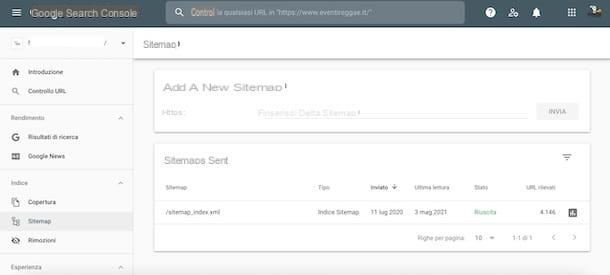
As just mentioned, the Google robot (called Googlebot) constantly scans the Net for new websites and new content to index. Therefore, index a WordPress site on Google it should be a totally automatic operation.
However, to make it easier for the robot to crawl your site and allow its content to be indexed, it is useful to create one Sitemap XML, i.e. a file that collects all the URLs of the website, which must subsequently be sent to Google via the Search Console, an online and completely free tool that allows you to monitor the indexing status and optimize the visibility of your website.
To create an XML Sitemap on WordPress, you can use XML Sitemap: a free plugin that also allows you to automatically report to search engines (not only Google but also Bing, Yahoo e Ask) new content published.
To install this plugin and automatically create your XML Sitemap, go to the section Plugin WordPress and click on the button Add new placed at the top. In the new screen that appears, type "XML Sitemap" in the field Searching for plugins and, in the search results, click on the buttons Install adesso e Attiva related to the plugin in question. In case of problems, I leave you to my guide on how to use WordPress in which you can also find directions to install and activate new plugins.
At this point, the XML Sitemap will be generated automatically and will be sent to Google and other search engines on the first update of an existing content or the publication of a new article or page. Alternatively, you can submit it manually by accessing the sections Settings e XML Sitemap and clicking on the item your sitemap visible next to the item Notify Search Engines about.
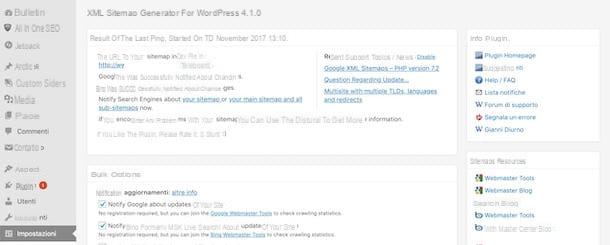
Once this is done, write down theURL of your XML Sitemap that you can see next to the item The URL to your sitemap index file is as you will need it to communicate the XML file in question to Google.
To do this, connected to the main page of Google Search Console, click on the button Sign up now and log in with your Google account. In the new screen that appears, select the option Mastery, enter your website address in the field example.com, award-winning Continue and follow the instructions shown on the screen, to verify that you are the owner of the website in question.
After that, select the option Sitemap located in the sidebar on the left, locate the box Add a new sitemap, enter the relative URL of your XML Sitemap (i.e. the part of the address that follows the domain extension), paste it in the field Enter the sitemap URL and click on the button Send: the message Sitemap submitted will confirm that your website's XML Sitemap has been submitted successfully.
At this point, indexing your content is only a matter of time. To check if your website is indexed on Google, connected to the main page of the search engine, enter the command site: sitename. [extension] (eg site: configurehow.com) in the search field and press the button Submit keyboard. Alternatively, by typing the command site: sitename. [extension] / pagename, you can check the indexing of a specific page of your website.
Finally, I want to underline that there are several plugins that allow you to create the XML Sitemap, including those that allow you to implement useful features from an SEO perspective (eg. Yoast SEO, Rank Math SEO etc.): if you use one of these plugins, make sure you have deactivated the option to create the XML Sitemap or, alternatively, do not use additional plugins to create it. To find out more, I leave you to my guide on how to create a sitemap.
How to rank a WordPress site on Google
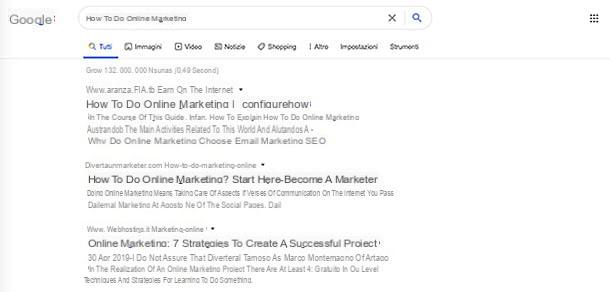
Unlike indexing, to place a WordPress site on Google it is a process that can take months or even years (if you have authoritative competitors) and that requires constant work on the contents published and to be published.
A valid method to try to position your website in the first results of the Google SERP is to rely on SEO (Search Engine Optimization), the set of all the optimization activities of a website aimed at improving its position on search engines and, consequently, increasing its visibility.
The first activity I recommend you to do is a thorough one keyword research through which you can identify the best keywords (i.e. those with a greater search volume and at the same time with less competitiveness) to use to create new pages or articles. To do this, you can rely on free tools such as Ubersuggest o Google Trends (in this case, my tutorial on how to use Google Trends might be useful) or choose to use paid tools (eg. SEOzoom) which also allow you to carry out an in-depth analysis competitor analysis.
The latter is another important activity that I recommend you to carry out to know which websites in your same sector are currently in the top positions of Google and which allows you to find out what their strengths are and which techniques they have put into practice to be reputed to be authoritative in the eyes of Google.
After identifying which keywords related to the topic covered by your website are that have a decent search volume and low competitiveness, start creating content by putting the reader first and not the search engines: divide, then , the content in paragraphs, use i header tag (H1, H2, H3 etc.) and, when necessary, create bulleted lists o numbered lists which facilitate reading.
Although it is important to offer detailed content that meets the needs of the reader, perhaps including those that only related searches with respect to the main search key, keep in mind that a long content no longer has the possibility of positioning itself compared to a shorter article: avoid, therefore, to write forcibly only to lengthen the content.
How do you say? Is writing valuable content enough to rank on Google? There quality content is certainly one of the most important factors to get the top positions on search engines but you must know that Google takes into account over 200 factors (Eg. site speed, user experience, optimization for mobile devices etc.) to decide which websites deserve to be in the top positions of the SERP.
Among these there is certainly the authority of a website which is also determined by inbound link. If your content is valuable, I assure you that you will be able to receive links from other websites in a completely spontaneous way but you must know that there are also different strategies for obtaining links from authoritative sites. In this regard, my guide on how to do link building may be useful.
Finally, if you are just starting out in the world of SEO, I recommend that you read the introductory guide to search engine optimization and the instructions for webmasters from Google, in order to become familiar with the activity of optimization. In addition, you can also take a look at my guide on how to be on the first page on Google in which you will find some useful tips to position your website on the famous search engine.
How to block WordPress site indexing
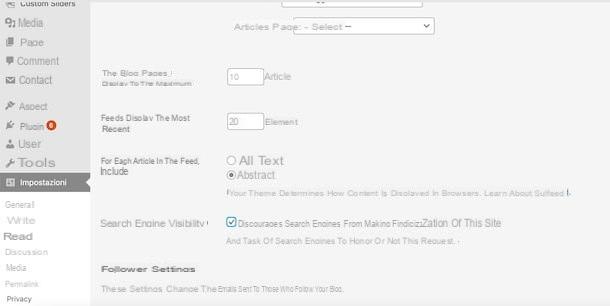
If for any reason you have the need to block indexing of a WordPress site, you must know that you can do it directly from the administration panel of the famous CMS.
To proceed, log in to Dashboard of WordPress of the website you want to de-index, click on the item Settings in the left sidebar and select the option Reading. In the new screen that appears, locate the section Visibility to search engines, put the check mark next to the item Discourage search engines from indexing this site and click on the button Save Changes, to save the new settings.
Alternatively, you can also proceed manually by going to edit the file robot.txt, a simple text file that contains information and instructions readable by search engines, so that they are able to understand which pages of your website they can scan.
To modify the file in question, which is located in the directory of your web space, you can use one of the programs for FTP (eg. fileZilla) that allow you to create a connection with the server hosting your website and upload / download files from it.
After recovering the robot.txt, all you have to do is enter the commands on two consecutive lines User-agent: * is Disallow: / and save your changes.
How to index a WordPress site












